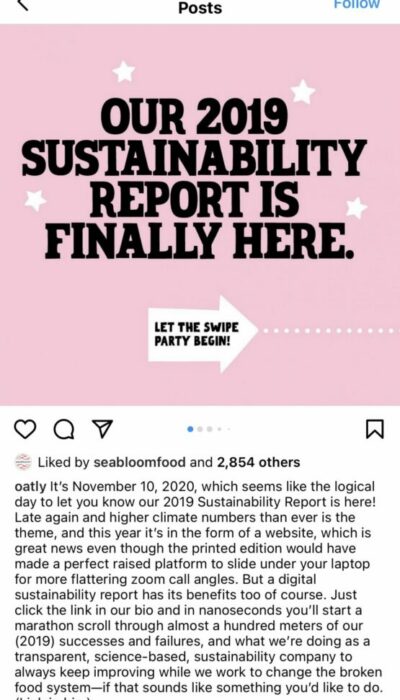HOW TO BECOME A CULT BRAND – Part 2
👋 Hi, Dan again. Welcome to Part 2! Now you’re on the way to building your very own cult brand…
I’ve spent years tracking what I consider to be shining examples of cult brands – which is not easy, as there aren’t that many. But if you start digging deeper there are certain key traits these brands all share.
Every brand that inspires a cult like following, every one of them that has a line out the door every day, they’re doing most of these. Many of you want to build more of a community and wish people engaged more with your story. But you don’t often don’t have the time or knowledge to make it happen.
So I’m going to make this simple for you. In this two-part series, we’re going to dive in to the CULT BRAND TEN COMMANDMENTS (here →)
Cult [n] – someone or something that a particular group of people are very enthusiastic about but that most people do not like or know about. A group or sect bound together by veneration of the same thing, person, ideal, etc.
In its purest form, a cult brand is one that inspires a fanatical devotion among its followers. They take a lot of work to set up and then a lot of work to maintain because if your followers think you’re being fake or selling out, you’ve lost them forever.
But the rewards can be huge, building a customer base who will support you through the good times and bad and buy anything you put out whilst screaming about you to the world.

Let’s break down the second lot of commandments!
COUNTERTALK NOTE: This article is abbreviated from Dan’s longer blog post, which features extensive real-life examples from his own work with Chick’n’Sours, Flat Iron, Dishoom and more. You can find that here.
In the meantime, get started with this invaluable toolkit. Your cult status awaits.
6. You communicate radical transparency
This is the science of storytelling. The more drama and emotion you share in what you’re doing, the more it will trigger action- commenting on your post, signing up to your newsletter, hitting the sales button or just emotional connection which will result in action somewhere down the line.
I would caveat this with the most enduring stories that have stood the test of time normally have happy endings . So, while radical transparency is great, you need to be careful not to make it a non stop moan fest either. Your primary goal is to give people value and uplift them.
By all means share the struggles, but balance it with struggles you have overcome so people can learn from you and associate you with positive and uplifting feelings.
ACTION PLAN:
People follow people, not brands. They want to follow people who are making the best possible go of their brief shot at life – the ups and the downs. Restaurant opening was a nightmare – share it. Covid forcing you to make very hard decisions – share it. Waking up with anxiety every day because this is so goddamn hard – share it.
Pick a story from either a challenge you overcame when you started off, from a challenge you’re facing now or the challenges to overcome your vision for the business and what you did (or are doing) to overcome them.
The bigger the challenge, the more of your emotions you can put into it. How were you feeling at every step as that will make people connect more. Share it.
7. You build a lifestyle around your brand
Taking this idea of DOING THINGS further, the best cult brands who have their values nailed down and actively live them then look at other ways to bring this purpose to people to encourage a lifestyle that supports these values every day. This is one of the highest points a brand can get to – when you transcend your product and become a symbol.
This is ambitious and might be phase 2 for many of you once your business hits a level of stability, but no-one said it would be easy! Maybe some of those ways make you money, or maybe they help strengthen your community.
ACTION PLAN:
Cookbooks, meal kits, sauce bottles, cook-alongs and events all have value here. They’re not just revenue earners but tools for your tribe to express themselves and live your shared values whilst connecting with others who feel the same.
This can just be fantasy planning for now, but think – what is one non-core thing I can do that still fits with values/principles that can bring people closer to my product/service, and helps them in their day to day lives?
8. You have fun and take risks
Having fun and taking risks is a key part of being a cult brand. You know what you stand for and stand against. Now how about having some fun pushing that to your edge? This sounds so simple, but when was the last time your brand did something fun just for the hell of it? When was the last time you saw another brand do that?
ACTION PLAN:
What’s something random and fun you can do that still fits in with your values? Is there something you want to say that others are too scared to? Can you say it in a fun way?
EXAMPLE:
For a lot of brands trying to do good in the world, it’s very hard to talk about your purpose without being preachy and ultimately a bit boring, no matter how important the message.
Oatly are a great example of many things – but for me, when it comes to getting a serious message across in a fun, light-hearted and unique way, no-one does it like them. For those that think Instagram is only for pictures and short inane captions – words count too when done right.
Here they share their sustainability report in a very open way, saying what they’re trying to do and where they’ve failed, and they’ve done it with their usual quirky humour
Check the report out also – you can’t deny they’ve done everything possible to make what could have been another dull snoozefest as interesting as possible both with words and visuals. A great example that you can bring fun into anything if you think creatively enough

9. You break accepted industry norms
An excellent book on building a unique brand is ‘Zag’ from brand guru Marty Neuimeier which I highly recommend. His central argument is that you really want to be #1-3 in your space to win. If that’s not possible, which most times it isn’t, then create a new space so you can be #1 in it.
Most cult brands were born out of breaking norms, which meant they were suddenly #1 in a new space. Flat Iron doing high quality, affordable steaks with a great customer experience, Oatly transforming oat milk from a hippy-ish product into a fashionable lifestyle choice, Sipsmith breaking the norm that non-alcoholic drinks couldn’t be a luxury experience.
ACTION PLAN:
The idea is that you have a service/product that is unique as possible and the best way to do that is going against the accepted norms, because often when you start questioning why they exist, there’s a lot wrong with them.
On a small level there may be other ways for you to challenge norms in your industry; not just with your product, but around customer experience, internal culture, pricing, availability etc. This is how you create a new space for you to be the leader and show you have the courage to stand up for your beliefs and be a leader for your tribe.
Make a list of accepted norms in your industry. Find one that seems a bit stupid to you. What can you do or are you doing to go against that? Then share a post on it (but only if you already live it!)
10. You use scarcity and exclusivity to build HYPE
Scarcity and exclusivity are a great way to build excitement, rabid loyalty and sales. A lot of cult brands are born out of the difficulty in actually getting your hands on them!
Sometimes this is just due to availability as a brand won’t make more without violating their principles (staffing or other resources), or sometimes it’s the availability of physical spaces – like trying to get into Dishoom or Padella.
Other times it can be a limited edition run of either a core product or something related to your values. These are a great way to tick a lot of boxes – have fun, build hype, show your process and why you do things, get your community involved to shape the product and keep pushing your brand and learning so things so don’t stay stale.
ACTION PLAN:
Making it hard to get things seems so counter-intuitive, but that’s humans for you! The harder you make it for people to join the club, the more excited they’ll be once they’re in, and the more of a status it is to share.
What can you make a limited run of? Try and make it something exciting people will lose their shit over. Build up the hype on your social channels – talk about what you’re doing, show the process behind it and say you’re only doing a few of them. Then launch it for a brief window of time. Think of something, however small you can add to this to really make it a great experience for your customers somewhere along the buying journey.
For those that are willing to go through hardship to get your product, make it worth their while. Give them some extra things to make it feel special and the experience to be unique – whether it’s Dishoom giving people free food in the line or Flat Iron giving you free popcorn when you sit down, you should always reward people for making the effort.

CONCLUSION:
So should everyone be a cult brand? Should YOU be a cult brand?
If you ever saw a huge line for a place or someone sell out online in 2 hours and think ‘that would be nice’. Now you know – you can do it too, if you’re willing to work for it.
I can say with confidence that if you focus on asking yourself at every step ‘Am I giving my customers an amazing experience that fits in with my values or am I just trying to tick a box’ and come at it from a place of serving others, the upsides for you as a human and a business owner are huge.
If every company had some level of purpose, even if that’s just making your customers lives better and creating a work culture where employees are proud to represent you and your values, it certainly wouldn’t make the world a worse place.
So I ask again, how bad do you want to create something unique that brings joy to the lives of your community? More than your competitors?
FINAL ACTION PLAN:
I threw a lot at you there. So here’s the one thing. When planning your next monthly activities ask yourself: what is one thing I can improve on in the list above? Can I share a very honest story that makes us look like humans. Is there some way I can give something to 1 customer, 10 customers, 100 and expect nothing in return?
All the greatest achievements in life have been born out of discomfort. The more uncomfortable it makes you feel, the more impact it will have so close your eyes, focus on your vision and what it means to you and press the button!
Worst case, make a donation to a cause you believe in or give some free food to someone that needs it.
I hope this blog post made you think a bit about ways you can be more true to yourself and generate more love and connection from your customers. If it resonated with you then feel free to share it with someone who could benefit from it too…
And if you made it this far I’m truly grateful for you to take the time to read this.
DAN NASH is a Brand Strategist & Founder of SixEight.
For 5 years Dan has helped food brands like Tonkotsu, Dishoom and Flat Iron turn customers into a cult of superfans through his unique 3 step Cult Brand System, creating a human personality for brands to attract their tribe and create more sales. He says: “The system makes it easy to tell a never-ending story that stands out from the noise and build a tribe for life”.
It’s his mission to make food brands become a force for good, behave more like humans and generate the same intense love as the best brands in the world.
That’s how he’s smashed restaurant launches, built engaged communities and turned customers into passionate fans who keep coming back whilst shouting about it to the world.
We are thrilled to have Dan’s incredible insight and expertise at our upcoming BRAND STORYTELLING event – link to tickets here.

